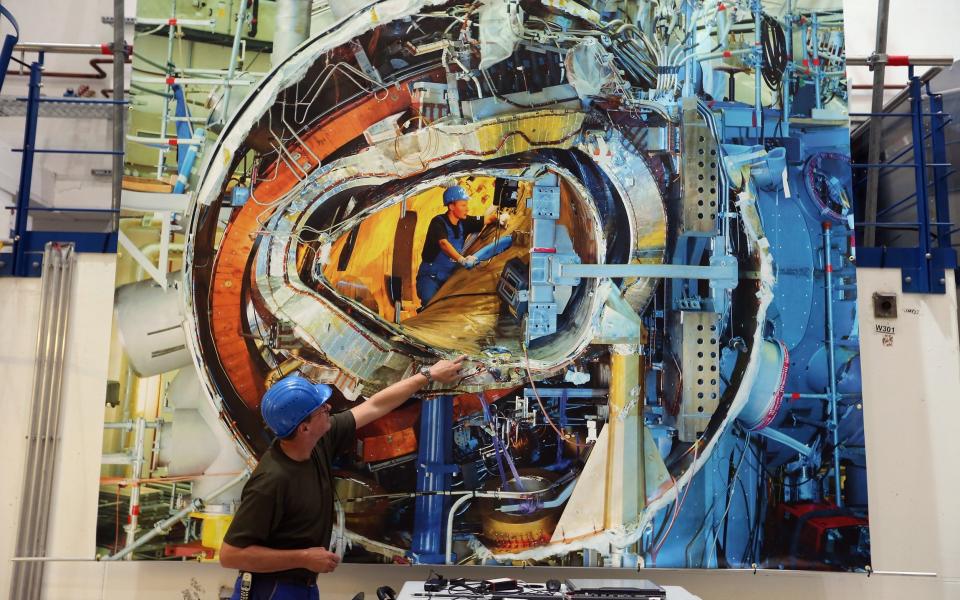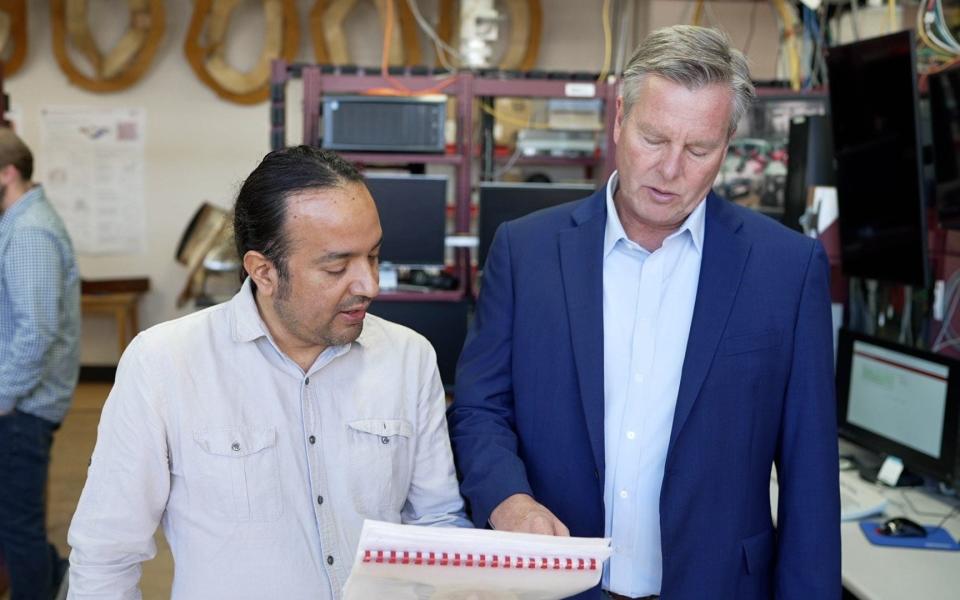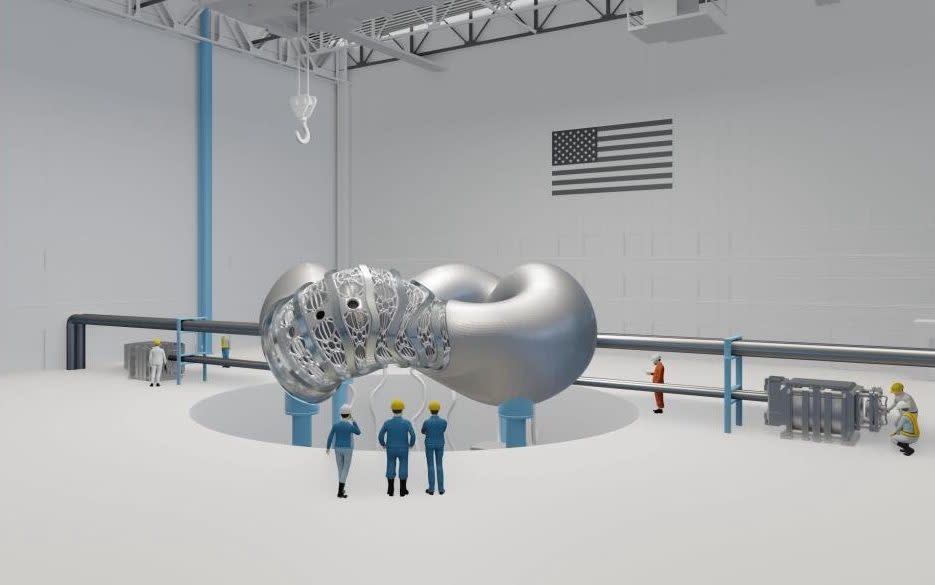The ‘twisted doughnut’ reactor that could bring nuclear fusion a step closer

Nuclear fusion may be a step closer after a radical new reactor design shaped like a twisted doughnut was unveiled by a task force set up by the King.
The reactor, known as a stellarator, offers new ways of controlling the white hot plasmas generated by nuclear fusion.
Fusion plasmas are so hot that they would melt any known material and so have to be contained in powerful magnetic fields. But maintaining such a magnetic cage for more than a few seconds has defied science for 70 years – perhaps until now.
Chris Mowry, chief executive of Type One Energy, says the company expects its first stellarator, Infinity One, to be installed in a disused power station in Tennessee from 2025.
Speaking at an event held by the fusion task force set up by the King’s Sustainable Markets Initiative, of which Mowry is also chairman, he said: “The machine will be experimental but is expected to produce more power than it consumes – opening the way to commercial development.”
The announcement, along with separate fusion reactor plans from the UK and China, signals a potential breakthrough in fusion design. It also shows how fusion is moving from a mainly scientific venture into a race to build the first commercially viable reactors.

That progress caught the eye of the Sustainable Markets Initiative, set up in 2020 by the King when he was the Prince of Wales, prompting the recent creation of the task force.
“A gram of fusion fuel could release as much energy as burning 10,000 kg of coal,” says Mowry. “So you could generate the power for a 250,000-person city for a year with only a few hundred kilograms of deuterium and lithium. I expect to see a commercial reactor within two decades.”
Such promises have been made before, and the target remains highly ambitious. Scientists first harnessed fusion power nearly 70 years ago with the development of the hydrogen bomb.
Controlling such reactions to produce energy has, however, proved impossible, despite the billions of pounds spent on research.
This is because the temperatures needed to create fusion plasmas — 10 to 15 times hotter than the sun — would melt all known materials.
It means they have to be contained by magnetic fields, but designing the magnets and modelling their fields into a cage capable of containing white-hot plasmas for long periods has proved an impossible problem.
Mowry and his UK colleagues on the fusion taskforce believe they can now solve this and the other technical barriers that have left fusion power always “40 years in the future” for the last seven decades.
In fusion the aim is to use extremely high temperatures and pressures to force hydrogen atoms to fuse, creating helium. This process, which also fuels the sun and other stars, destroys a tiny fraction of their mass, converting it into massive amounts of heat energy. If controlled this can be used to generate low carbon electricity.
Mowry says: “The idea is simple but modelling the physics of that process, especially the magnetic fields is extremely complex. And to do it in three dimensions has really been beyond the power of computing until the last five or 10 years.
“What’s happened is that modern supercomputing, which was developed in the last 20 years, allows scientists to calculate the shape of one of these machines and then build it.”
Mowry’s comments reflect a wider excitement across the fusion science community around hopes for a commercially viable technology. Fusion research in the US has coincided with a resurgence of interest in the UK too, partly linked to a burst of enthusiasm from Boris Johnson in 2019 when he was prime minister.
He announced £330m for fusion research, and told the Conservative party conference that research at the Joint European Torus (JET) project at Culham, near Oxford, would soon lead to “virtually unlimited zero-carbon power”.
His claim was overstated but the money has helped the UK remain a world leader with plans for its own new fusion reactor, a replacement for JET. The Spherical Tokamak for Energy Production (Step) will be built in a disused power station in West Burton, Nottinghamshire.
Tokamaks are an older approach to fusion with a simple doughnut-shaped reactor. Around 200 have been built over the last seven decades, generating invaluable data, but none has proved capable of maintaining sustained fusion reactions.
Paul Methven, chief executive of UK Industrial Fusion Solutions, which is building Step says: “Step will pave the way for commercially viable fusion and help develop the UK supply chain. It’s a vital and exciting opportunity to lead and deliver a new solution for the climate, to help keep Britain at the forefront of the commercial delivery of fusion.”
The UK and US are friendly rivals, collaborating as well as competing to develop the technology. But there are other players too.
China announced five years ago that it also planned to build a nuclear fusion power station and has been training 3,000 engineers for the project.
Delong Luo, director-general of China’s fusion research agency, has said he plans an experimental fusion reactor by 2035. A prototype power station envisaged for 2060 would be followed by commercial plants.
China and the US are also lead partners in the ITER project in southern France where a consortium of 10 nations are building the world’s largest fusion reactor. It too is a tokamak, designed only to generate experimental data. Britain was part of the ITER consortium through its membership of the EU but was thrown out after Brexit.
Mowry believes fusion research needs to get over the tokamak design. He suggests it belongs in the 1970s and will never be able to produce the stable magnetic fields needed for sustained fusion.
“The tokamak doughnut design is a simple geometry, which is why in the 1960s and 70s, before the advent of high performance computing, it was much easier to develop and produce these shapes of reactor,” he says. “But the plasma is inherently not stable so it cannot reach a continuous steady-state needed for energy production.”
Mowry and his colleagues used access to the US Department of Defence’s Exascale computing project to try to solve those problems. Exascale computing refers to the capability to perform a billion-billion calculations operations per second – a speed comparable to the interactions within a fusion reactor.
The design that emerged looked like a tokamak run over by a tank – a twisted doughnut. But the real power of the computing lay not just in the shape but in working out how to build and maintain the magnetic fields inside the reactor.

“The idea of a stellarator is that if you can figure out exactly how it twists and how to control the magnetic fields it brings a lot of goodness with it,” says Mowry. “Above all it makes the machine inherently stable to produce energy that we can use.”
If he is right then fusion may indeed be just one or two decades away, and Britain will share the benefits. Last December the US and UK signed an agreement to work together on such projects, and whichever design proves successful, the science will be largely shared.
Perhaps the most crucial question, however, is how much it will all cost. The UK’s latest venture into atomic energy, the Hinkley Point C power station in Somerset, has seen costs surge from £18bn to £46bn. And that relies on nuclear fission, where Britain has decades of experience.
Sir Ian Chapman, chief executive of the UK Atomic Energy Authority, points out that one of the biggest costs of nuclear power stations comes from having to deal with the radioactive materials and wastes.
Fusion, by contrast, generates no long-lived nuclear waste, so any power station based on it could be relatively tiny, perhaps the size of a supermarket.
“Jet, our last machine, would have cost £2bn in today’s money,” says Sir Ian. “The next generation will have more technology so it will definitely cost more. But it will be a lot less than the tens of billions we are seeing at Hinkley. And it will be clean.”

 Yahoo Finance
Yahoo Finance 